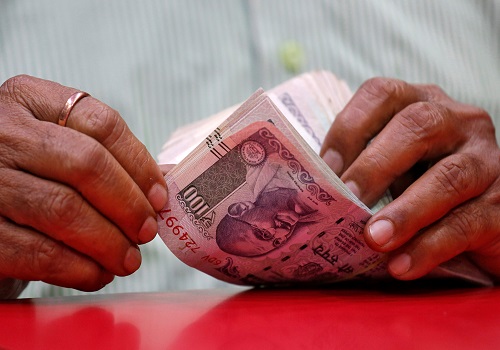Agri Commodity Technical Report 12 July 2023 - Geojit Financial Services

Follow us Now on Telegram ! Get daily 10 - 12 important updates on Business, Finance and Investment. Join our Telegram Channel
SPICES
• India's export of spices in the year ended March declined 8.3% on year to 1.4 million ton, according to data from the Spices Board India. However, in value terms, exports rose 4.7% to 317.6 billion rupees in 2022-23. While exports of most spices fell, those that registered a rise included turmeric, garlic and coriander. Garlic exports rose 159% on year to 57,346 ton in 2022-23. Exports of cumin declined 14% on year to 186,509 ton in 2022- 23, while turmeric exports rose 11% on year to 170,085 tn. India exported 54,482 ton of coriander in 2022-23, up 12%, the data showed. Exports of small cardamom declined 30% on year to 7,352 ton and large cardamom fell 5% on year to 1,884 tn. Exports of chilli in 2022-23 declined 7% on year at 516,185 ton, while pepper fell 18% to 17,958 ton, according to the data.
• According to Gujarat government's third advance estimates released, jeera production is estimated to fall 9.3% on year to 200,780 tn. Gujarat is the second-largest producer of the commodity.
• Coriander production is seen to rise 81% on year to 376,090 tn in Gujarat, according to the state government's third advance estimates.
COTTON
• Sowing of kharif crops have made good progress so far as rainfall over the country has picked up in the last one week. As of Friday, farmers have sown crops across 20.3 million ha in the 2023-24 (Jul-Jun) kharif season, which is slightly higher than 20.2 million ha sown in the corresponding period last year. So far, the total area under cotton is 4.0 million ha against 4.7 million ha a year ago.
• The Cotton Association of India on Tuesday retained its estimate on the country's cotton production in the current season ending September at 29.84 mln bales (1 bale = 170 kg). The crop committee will update its crop estimate and cotton balance sheet for the season after the association's national committee meeting on Jul 10, the association said in a release. Due to differences in estimates by various agencies for the current crop year, the committee decided to convene an all-India meeting on Jul 10 for arriving at an accurate crop estimate for 2022-23, it said. The committee estimated all India cotton pressing at May end at 25.63 mln bales, the association said in a release.
• The US Department of Agriculture has projected global cotton production in 2023-24 (Aug-Jul) to rise by 1 mln bales to 116.7 mln bales on account of larger crops in US and Pakistan offsetting the decline in China. Opening stocks are seen higher by 254,000 bales at 92.8 mln bales as consumption prospects for 2022-23 are estimated to decline by 538,000 bales from the previous projection. Cotton production in India and Brazil in 2023-24 is seen steady at 25.5 mln bales and 13.25 mln bales, respectively. However, production in Pakistan is seen higher by 600,000 bales at 5.9 mln bales. The agency has projected global cotton consumption in 2023-24 to rise by 765,000 bales to 117 mln bales, due to an increase in consumption in Vietnam, Pakistan, Bangladesh, and Turkey. Consumption in India and Brazil is estimated to be steady at 24.5 mln bales and 3.3 mln bales, respectively. While in Pakistan it is projected to rise by 200,000 bales to 9.8 mln bales. The USDA has projected cotton exports from India in 2023-24 to be steady at 2.4 mln bales from the previous month's projections. Cotton ending stocks in India is seen at 11.2 mln bales in 2023-24, up from previous projection of 10.55 mln bales, the report said.
• The Cotton Association of India has scaled down its estimate for cotton production in India in the 2022-23 (OctSep) season by 465,000 bales (1 bale = 170 kg) to 29.84 mln bales, it said in a release. The total supply of cotton between October 2022 and April 2023 is now estimated at 26.30 mln bales – arrivals of 22.41 mln bales, imports of 700,000 bales, and an opening stock of 3.19 mln bales at the beginning of the season. For Oct-Apr, cotton consumption has been estimated at 17.9 mln bales, while export shipments till Apr 30 are estimated at 1.2 mln bales. According to the association, stocks at the end of April are estimated at 7.20 mln bales – 5.20 mln bales with textile mills and 2.0 mln bales with Cotton Corp of India, Maharashtra Federation, and multinational corporations, traders, and ginners. This includes the cotton sold but not delivered. Total supply of cotton during the 2022-23 season has been estimated at 35 mln bales, unchanged from the association's last estimate.

OTHERS
• The National Agricultural Cooperative Marketing Federation of India has purchased 2.34 mln tn chana under the price support scheme in its ongoing rabi procurement operations, the agency said in a tweet. The agency said 1.02 mln farmers benefitted from the procurement and a sum of 125.10 bln rupees was paid to them. The government has set the minimum support price for chana at 5,335 rupees per 100 kg for the 2023-24 rabi marketing season. In this round of procurement, the agency purchased chana in Telangana, Gujarat, Andhra Pradesh, Karnataka, Maharashtra, Madhya Pradesh, Uttar Pradesh, and Rajasthan, it said. Madhya Pradesh recorded the highest procurement at 797,205.88 tn, followed by Maharashtra and Gujarat at 773,650.09 tn and 328,582.41 tn, respectively.
• According to the third advance estimate released by the farm ministry, pulses output is seen at 27.5 mln tn in the ongoing crop year, as against 27.3 mln tn in the previous year. Chana output for 2022-23 is pegged at 13.5 mln tn largely unchanged from 2021-22. Tur output is seen at 3.4 mln tn compared with 4.2 mln tn in the final estimate of last year.
• Agriculture and Agri-Food Canada has scaled down its estimate for chickpea prices in Canada for 2022-23 (Aug-Jul) to $1,035 per tn from $1,165 per tn projected in February. It has also lowered its estimates for mustard seed prices to $2,365 per tn from $2,525 per tn projected last month. In its March report, the farm agency said the average price of mustard seed is forecast to fall, but remain historically high due to expectations of increased carry-out stocks in Canada. The estimate for overall supply of chickpeas in Canada is unchanged from last month at 328,000 tn. The agency has also kept exports of chickpea steady at 200,000 tn. Similarly, estimates for overall supply and exports of mustard seed are unchanged at 177,000 tn and 115,000 tn, respectively. The agency left its price estimates for lentils, dry beans and dry peas unchanged from last month at $800 per tn, $1,165 per tn and $460 per tn, respectively. Canada is one of the biggest exporters of lentils to India. Agriculture and Agri-Food Canada is responsible for policies governing production, processing and marketing of farm, food and agribased products in Canada.
• According to 2nd Advance Estimates released by farm ministry, pulses output is seen at 27.8 mln tn in the ongoing crop year, as against 27.3 mln tn in the previous year. Chana output for 2022-23 is pegged at 13.6 mln tn compared with 13.5 mln tn in 2021-22. Tur output is seen at 3.7 mln tn compared to 4.2 mln tn in the final estimate of last year.
• In the month of April 2023, India’s guar split exports saw a jump of 16% to 3,500 tonnes at an average FoB of US$ 1489 per tonne, as compared to 3,010 tonnes in the month of March ’23 at an average FoB of US$ 1,646 per tonne. However, the guar split shipments went down by 13% as compared to the same period last year. This month, China was the only importer of guar split. The Guar gum exports in the month of April 2023 dropped down by 14.6% to 16,219 tonnes at an average FoB of US $1,455 per tonne as compared to 19,001 tonnes in the month of March 2023 at a FoB of US $1,558 per tonne. Further, the gum shipments also went down by 15% in April ’23 as compared to the corresponding year. Among the total exported quantity, Russia purchased approximately 3,349 tonnes, the USA bought 2,990 tonnes, China acquired 1,961 tonnes, and Germany imported 1,808 tonnes.
OIL AND OILSEEDS
• Farmers have sown soybean across 9.05 mln ha this kharif season so far, down 21% on year, according to a survey conducted by the Soybean Processors Association of India. According to the farm ministry, soybean acreage is 5.55 mln ha so far in the ongoing season. "We estimate that the total area under soybean this year may be slightly lower than last year because of delay in onset of monsoon and some m inor shift to other crops," SOPA said.
• India's soymeal exports in June rose 31.6% on year to 50,000 tn, the Soybean Processors Association of India said. For Oct-Jun, soymeal exports increased to 1.57 mln tn from 564,000 tn a year ago. The 2022-23 kharif season began in October. Soymeal is primarily used as poultry and livestock feed. Indian soymeal is non-genetically modified and considered rich in protein. In June, production of soymeal rose to 602,000 tn from 539,000 tn a year ago. The output for Oct-Jun was 6.82 mln tn, up from 4.99 mln tn in the year-ago period, SOPA said. Soybean arrivals in spot markets totalled 800,000 tn in June, up from 500,000 tn last year. During Oct-Jun, arrivals rose to 9.9 mln tn from 7.5 mln tn in the year-ago period. By the end of June, mills, traders, and farmers were left with around 5.2 mln tn of soybean stock, the association said. Soybean, a kharif oilseed, is sown during Jun-Jul and harvested in Sep-Oct.
• The production of crude palm oil in Malaysia fell 4.6% on month to 1.45 mln tn in June, data from the Malaysian Palm Oil Board showed.Exports of palm oil in June rose 8.6% on month to 1.17 mln tn, while those of biodiesel fell 4.7% on month to 12,927 tn, the data showed. Palm oil is also used to make biofuel. Total stocks of palm oil in the country rose 1.9% on month to 1.72 mln tn as of June end, highest since February. Malaysia is the world's second-largest producer of crude palm oil, and India is the largest consumer of edible oils in the world.
• India's oilmeal exports surged 72% on year to 436,596 tn in May, data released by the Solvent Extractors' Association of India showed. The rise in exports was primarily on account of higher shipment of mustard meal, soymeal, and castor seed meal. In May, the country exported 233,663 tn mustard meal, significantly higher than 169,148 tn in the year-ago period. Exports of castor seed meal rose to 43,761 tn from 31,157 tn a year ago, and those of soymeal rose 512% to 114,228 tn. The country's total oilmeal exports during Apr-May rose 58.6% to 930,044 tn. During the period, the export of mustard meal rose to 480,231 tn against 398,356 tn in the year-ago period, and those of soymeal rose 568% to 291,471 tn. During Apr-May, South Korea imported 189,704 tn of oilmeals from India compared with 216,789 tn a year ago, while Vietnam imported 142,285 tn from India, against 125,598 tn a year ago, the association said. In Apr-May, 241,410 tn oilmeals were exported from Kandla port against 199,377 tn a year ago. About 300,187 tn were exported from Mundra port, up 76% from last year. Exports from Mumbai port, including Jawaharlal Nehru Port Trust, were at 93,454 tn against 36,535 tn a year ago. Around 52,130 tn of oilmeals were shipped from Kolkata port compared with 63,266 tn a year ago, along with 242,863 tn from other ports, up 108%, the association said.
• The US Department of Agriculture has projected global oilseed output in 2023-24 (May-Apr) marginally higher at 671.4 mln tn from 671.2 mln tn forecast last month. The 2023-24 global soybean outlook includes higher beginning stocks, lower crush, and higher ending stocks, the US agency said in a report. Global 2023-24 ending stocks are increased by 0.8 mln tn to 123.3 mln tn with higher stocks for the US, Brazil, and the European Union, which are partly offset by lower stocks for Argentina and Vietnam, it said. The agency has projected global soybean output to rise to 410.7 mln tn from 410.6 mln tn. Brazil's soybean crop is estimated at a record 163.0 mln tn, unchanged from last month, and Argentina's is seen at 48.0 mln tn, according to the report. The agency has estimated soybean production in the US at 122.7 mln tn. Brazil is the world's top producer of soybean followed by the US and Argentina. "The soybean price is forecast at $12.10 per bushel, unchanged from last month," the agency said in its report. The estimate for global soyoil production for 2023-24 has been revised downwards to 62.4 mln tn as against 62.5 mln tn projected last month. The estimate for global soyoil exports in 2023-24 has been revised lower to 11.7 mln tn from 11.8 mln tn. The department projected global soymeal output for 2023-24 at 260.5 mln tn, down from 260.9 mln tn estimated last month. Soymeal is a derivative of soybean, manufactured by crushing the oilseed, and is mainly used in producing poultry feed.
• The National Agricultural Cooperative Marketing Federation of India has purchased 755,472 tn of mustard seeds under the price support scheme in its rabi procurement operations, the agency said in a tweet. As many as 325,213 farmers benefitted from the procurement and 41.17 bln rupees was paid to them, the agency said. The government has set the minimum support price for mustard at 5,450 rupees per 100 kg for the 2023-24 rabi marketing season, against 5,050 rupees per 100 kg last year. In this round of procurement, the National Agricultural Cooperative Marketing Federation of India purchased mustard in Haryana, Guajarat, Rajasthan, Uttar Pradesh, and Madhya Pradesh. In its third advance estimate, the government has pegged India's mustard production in the 2022-23 (Jul-Jun) crop year at 12.5 mln tn, against 12.0 mln tn the previous year.
• The Department of Food and Public Distribution has asked domestic oil producers' associations to ensure that the maximum retail price of major edible oils is cut further by 8-12 rupees per ltr with immediate effect.Domestic edible oil associations informed the government they will further reduce retail prices at a meeting convened by the Department of Food and Public Distribution Secretary Sanjeev Chopra Friday.The government convened the second meeting with domestic oil producers' associations including the Solvent Extraction Association of India and the Indian Vegetable Oil Producers’ Association to discuss further reduction in retail prices of edible oil amidst the fall in global prices.It was discussed in the meeting that the international prices of imported edible oils are continuing on a downward trend and the edible oil industry needs to ensure that the prices in the domestic market also drop commensurately.The associations informed that the global prices of different edible oils have fallen by $150-$200 per tn in the last two months and there is an element of time lag for reflection in the retail markets and the maximum retail prices are soon expected to drop further.Some major brands have cut the prices of refined sunflower and refined soybean oil by 5-15 rupees per ltr after a meeting with the department earlier. Similar reduction has been done in mustard oil and other edible oils as well. The reduction in oil prices came in the wake of reduction of international prices and reduced import duty on edible oils making them cheaper. The associations were then advised to ensure that the entire benefit of the reduced international prices be passed on to consumers invariably.
• India's vegetable oil imports rose 15% on year to 1.05 mln tn in April, the Solvent Extractors' Association of India said. Vegetable oil imports in the first six months of the oil year beginning November were at 8.11 mln tn as against 6.71 mln tn a year ago, marking a rise of 21%. Meanwhile, edible oil imports for these six months were at 8.00 mln tn as against 6.54 mln tn a year ago. The vegetable oil basket consists of edible and non-edible oils. The edible oil import basket comprises crude and refined palm oils, crude soyoil, and sunflower oil. India imports palm oil from Indonesia and Malaysia, and soyoil from Argentina. Sunflower oil is imported from Ukraine and Russia. India is the world's largest importer of edible oils. As of May 1, about 736,000 tn of edible oil was at ports as against 416,000 tn a year ago. Around 2.6 mln tn was in the pipeline as against 1.8 mln tn in the same period last year, the Solvent Extractors' Association of India said.
To Read Complete Report & Disclaimer Click Here
For More Geojit Financial Services Ltd Disclaimer https://www.geojit.com/disclaimer
SEBI Registration Number: INH200000345
Views express by all participants are for information & academic purpose only. Kindly read disclaimer before referring below views. Click Here For Disclaimer










Tag News

We anticipate immense potential benefits from the upcoming Sovereign Gold Bond Tranche in FY...
More News

Base metals prices traded firm on Wednesday with most of the metals gained in the opening tr...





 320-x-100_uti_gold.jpg" alt="Advertisement">
320-x-100_uti_gold.jpg" alt="Advertisement">







